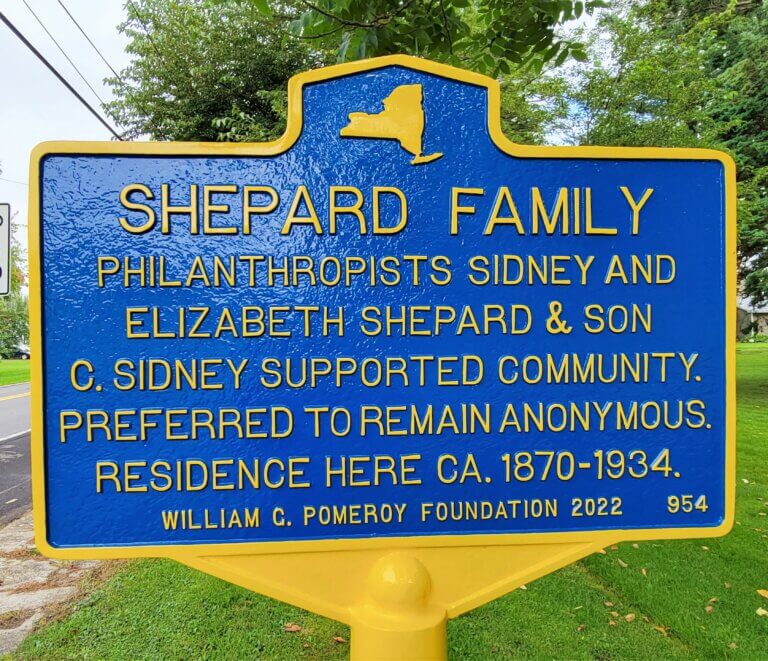SHEPARD FAMILY
- Program
- Subject
- Location
- Lat/Long
- Grant Recipient
-
NYS Historic
-
People, Site
- 3640 6, New Haven, NY 13114, USA
- 43.480330947593, -76.314740763074
-
Town of New Haven
SHEPARD FAMILY
Inscription
SHEPARD FAMILYPHILANTHROPISTS SIDNEY AND
ELIZABETH SHEPARD & SON
C. SIDNEY SUPPORTED COMMUNITY.
PREFERRED TO REMAIN ANONYMOUS.
RESIDENCE HERE CA. 1870-1934.
WILLIAM G. POMEROY FOUNDATION 2022
Though the Shepard Family had ties to the New Haven, New York community dating all the way back to the 1830s, it was businessman Sidney Shepard and wife Elizabeth’s return to New Haven CA. 1870 following an international tour that led to an increase in charitable giving for the local community, church and several statewide educational and charitable organizations. Already proven philanthropists in their previous community of Buffalo, New York, Sidney and Elizabeth made New Haven their home, transforming Elizabeth’s childhood house into a sprawling country estate soon known as “La Bergerie” which translates to the sheepfold and the Shepard’s Place.
Sidney Shepard, a major share-holder for Western Union and the owner of a tin metal producer in Buffalo, quickly settled into a more relaxed life in New Haven, for all intents and purposes retiring until passing on his business interests to his son, Charles Sidney, who preferred to go by C. Sidney. In fact, in the 1870-1871 Oswego Directory, Sidney Shepard’s occupation was listed as farmer. While the last decades of his life were spent in comfort at “La Bergerie”, Sidney’s impressive rise as a businessmen in the decades prior was meteoric: from a childhood spent working in agriculture and farming, to owner of a small tinsmith business, to one of the top industrialists in the country by the time he retired.
Amidst his business success, Sidney met Elizabeth while the two were in Buffalo. Elizabeth, then Wells, was originally from New Haven, her father and mother being farmers in the area. Elizabeth was there in Buffalo living with her aunt at the “Mansion House”—her aunt had married into the Coe family, who was in possession of the aforementioned Mansion House—and Elizabeth spent her time receiving a cutting-edge education and giving tours of the place. In an anecdote included on page 111 of the Twenty-Eighth Publication of the Oswego County Historical Society: 1966-1967, it’s mentioned that, after visiting the Mansion House with a friend an infatuated Sidney was asked by his companion about their hostess, to which Sidney responded he thought he would marry her. Their hostess was Elizabeth and his prediction proved accurate: the two were wed in 1851.
Sidney and Elizabeth went on to have three children, though only one would outlive their parents. The death of their daughter, Elizabeth—or Lizzy—spurred the family from their house in Buffalo to an international trip, which would take them all over the European continent. During this trip Elizabeth’s father passed away, and upon returning stateside the Shepards purchased the New Haven house, moving in and settling into life in their new community after selling their Buffalo property.
The only Shepard child who would live into adulthood, C. Sidney followed in his parent’s footsteps when it came to charitable giving. Often branded as a recluse by reporters who struggled to get an interview with the businessman and philanthropist, C. Sidney was a noted entertainer who remained close with many of his Yale classmates. Like his father, who passed away in 1894, C. Sidney quickly established himself as an industrialist and continued to grow the family wealth through a number of ventures. C. Sidney stayed in “La Bergerie” with his mother following his father’s death and continued to improve the property, eventually building her an observatory tower as his mother was an amateur astrologist. The base of the observatory remained visible as of 2022, along with a chicken coop and the giant flagpole from the Shepard’s time on the property.
Elizabeth Shepard passed away in 1922 and C. Sidney would pass in while New York City in 1934. Though their property would eventually fall into disrepair and be torn down, the memory of the Shepard family and their philanthropy remains strong within the New Haven community. Though they preferred their donations remain anonymous, following their deaths organizations and individuals who benefited from their charity emerged, thanking their donors or being listed in their wills. Though not fully-encompassing, a list of their benefactress and donations include:
- The General Hospital in Oswego
- The Orphan Asylum
- The Home of the Friendless
- Cornell University
- The First Congressional Church of New Haven
- A Community Home in New Haven adjacent to the church
- Yale University
- The American Sunday School Union: C Sidney and Elizabeth Shepard also taught Sunday school services in New Haven
Letters between the Shephards and individuals exist detailing both charitable giving to those in need, as well as the former’s requests to remain anonymous.
In an article published in The Buffalo Times on November 26th, 1922 profiling C. Sidney Shepard and his estate in New Haven, it is stated:
His benefactions, those who lay claim to some knowledge of them say, are silent like himself. But they are wide in scope and generous, not confined in the township [New Haven] although he has befriended many there. He is always ready to extend his patronage to young people who are striving for education. He always makes sure they are earnest and he prefers to act anonymously.

